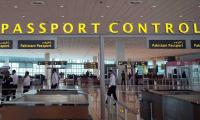The writer is a professor
at LUMS.
Several questions arise. What led to Imran Khan’s sudden climb-down from the lockdown of Islamabad? Was it due to the government’s change of strategy from 2014, while the PTI leader was still fighting the ‘last war’? Why did his party so conspicuously fail to mobilise Punjab? Why did the issue of corruption not sell?
The first lesson of the whole event is clear. With only 35 MNAs from the PTI and the other 307 MNAs belonging to other parliamentary parties not supporting the party, it had no locus standi to ask the prime minister to resign. It was clear from the beginning that the PTI’s support base had anything but expanded during the post-election period. Instead of opting for intensive political work at the grassroots level for months and years, it chose to activate street politics. Imran rushed from one issue to another and from one rally to another. He moved very fast only to stay put.
The PTI cadres and workers believed that this was the final push to bring Nawaz Sharif down. Their commitment to the word of their leader was ultimate. Not surprisingly, they are in a shock due to the anti-climax. But the indicators were clear. The PTI had not managed to get the people to Raiwind in large numbers. It had lost by-elections in Punjab one after the other. It was not able to cash in on the MQM’s four-fold division in Karachi.
Other indicators were equally important. People are getting used to the idea of an elected government’s mandate for five years. Article 58 (2) (b) is no more. Between the two martial law governments of Zia and Musharraf, four elected governments failed to complete their tenure due to this killer clause. What the 18th Amendment did was to establish the political community on firm grounds. Provincial autonomy, devolution, federalism and ethnic parties all became part of the ‘system’. Going it alone on the part of the PTI was doomed to repeat the performance of 2014 in 2016.
During the PTI’s build-up towards the lockdown, the government massively changed its strategy from letting the elephant into the bedroom, as in 2014, to keeping it at bay at the source. That was the undoing of Imran Khan’s strategy based on three slippery grounds: one, he relied as usual on raising the ante higher and higher in terms of demonising Nawaz Sharif. He accused him of being an accomplice of Modi and an agent of Israel. He wondered why events such as the massacre at the Quetta Police Training Centre and firing at the LoC took place when he announced his lockdown, thereby hinting at a link between Nawaz Sharif and India. Imran is half a century late in hurling such hackneyed accusations on political opponents. This is not the 1960s. Little did he realise that he was insulting the intelligence of the nation.
Two, Imran has shown an acute lack of sensitivity about the rules of the game. A judge warned him to respect the court, as did another judge a few years ago. Political parties wanted him to move in step with them on the Panama leaks. Perhaps his own colleagues got jittery about his lack of finesse in his role on the political stage. His comrades-at-arms – one from Canada and the other from Rawalpindi – could only be a source of embarrassment for a national leader.
Third, Imran’s obsession with the military’s role is bizarre. His habit of warning about the umpire’s finger robbed him of the legitimacy of being his own person. His use of threat of an impending disaster for parliament could be counterproductive because it has the effect of uniting the ranks of politicians from the government and the opposition against him. This happened in 2014. It would have happened this week if Imran had pressed the point further.
After Punjab was lost, all eyes were set on KP. What KP’s chief minister did has made history. Never before in Pakistan has a leader of one provincial government made an incursion into the territory of another government – Punjab – to reach Islamabad, while leading a cavalcade of public office-holders from Peshawar. Pervaiz Khattak warned of rebellion if he was stopped from entering Islamabad. The risk of putting one government against the other for the stability of the federation cannot be over-stressed. Indeed, Khattak introduced a potentially dangerous dichotomy between Punjab and KP. That was certainly not a contribution to inter-provincial harmony. His early return to Peshawar in the midst of confusion about the modus operandi of one provincial chief executive entering the other’s domain at the head of a highly charged crowd saved the situation.
Did the climb-down finally take place due to the higher judiciary’s demand for submission of ToR’s from both sides, instituting a commission of enquiry, its resolve to investigate the commission’s report and then give its verdict? Imran appealed against the Islamabad High Court’s decision to hold the meeting at Parade Ground but had to cancel the lockdown.
Interestingly, Imran’s preoccupation with numbers proved to be his Waterloo. It is highly improbable to gather together one million people for a public meeting – not only for Imran but also for any other leader. The MQM once boasted of that number and managed to get a quarter of it, largely and essentially from the city of Karachi. Gathering people together from the whole country without an infrastructure in place was a recipe for disaster for the PTI.
But what about corruption? Has the result of the mobilisation effort turned out to be the opposite of the desired end? The Panama leaks receded from the minds of people, overtaken by police shelling, a leader speaking to thunderous applause on the Motorway and a shadowy ‘cabinet’ sitting in Bani Gala. Why is corruption a bad sell? The political use of corruption in the form of dismissing governments of political leaders from the days of Khuhro to Junejo, Benazir Bhutto and Nawaz Sharif has been worn out. The public believes that the pursuit of ‘Big Fish’ has a purpose behind it, viz. to remove or justify the removal of an elected leader of a government.
Many variants of the public discourse for holding the corrupt leaders accountable are in circulation in the middle class. For example, if the prime minister is the most corrupt person in this country, then how can this nation prosper? If you nab him and make an example of him, others will automatically desist from the temptation for corruption. If you make him bring the nation’s wealth back, that will take care of the debt burden. This gimmickry is popular not only with the highly charged party activists but also with people outside the party ranks.
Corruption is essentially a middle-class issue, a crime that reflects the moral bankruptcy of the political class. In India, the BJP was able to garner vote out of right-wing mobilisation against the Congress government. This is an issue of the ultra-right in Pakistan as well. Asif Zardari was the target of a blitzkrieg against his alleged corruption, accompanied by a demand for return of money that would take care of the nation’s liabilities. Masses have been fed on this view of corruption focused on a highly-placed individual, the agenda of rendering him/her culpable and reaping political dividends. Otherwise, institutional loopholes, government by patronage rather than policy and absence of checks and balances at the district, sub-district and supra-district levels, intra-departmental level and ‘legalised’ corruption at the institutional level are the stuff that corruption is made of.
Whatever happened has incurred a colossal loss of human energy, political wisdom and peace in the country. The PTI leader owes an explanation to his workers and cadres at the very least.
Email: waseem@lums.edu.pk
To take part in revolution, farmers need resources to afford seed varieties, fertilisers, and cost of setting up tube...
Pakistan remains burdened by insufficient financial support, saddled with conditions that deepen dependency
Government implements key policy decisions aimed at stabilising the economy
This is not going to be feel-good, year-end piece where I will use motivational quotes to tell how resilient we are
State Bank overlook considerable challenges surrounding Pakistan's economy
Pakistan remains mired in what can only be described as a ‘Baby Boomer Syndrome’







